Linan Yue
GraphPrompter: Multi-stage Adaptive Prompt Optimization for Graph In-Context Learning
May 04, 2025Abstract:Graph In-Context Learning, with the ability to adapt pre-trained graph models to novel and diverse downstream graphs without updating any parameters, has gained much attention in the community. The key to graph in-context learning is to perform downstream graphs conditioned on chosen prompt examples. Existing methods randomly select subgraphs or edges as prompts, leading to noisy graph prompts and inferior model performance. Additionally, due to the gap between pre-training and testing graphs, when the number of classes in the testing graphs is much greater than that in the training, the in-context learning ability will also significantly deteriorate. To tackle the aforementioned challenges, we develop a multi-stage adaptive prompt optimization method GraphPrompter, which optimizes the entire process of generating, selecting, and using graph prompts for better in-context learning capabilities. Firstly, Prompt Generator introduces a reconstruction layer to highlight the most informative edges and reduce irrelevant noise for graph prompt construction. Furthermore, in the selection stage, Prompt Selector employs the $k$-nearest neighbors algorithm and pre-trained selection layers to dynamically choose appropriate samples and minimize the influence of irrelevant prompts. Finally, we leverage a Prompt Augmenter with a cache replacement strategy to enhance the generalization capability of the pre-trained model on new datasets. Extensive experiments show that GraphPrompter effectively enhances the in-context learning ability of graph models. On average across all the settings, our approach surpasses the state-of-the-art baselines by over 8%. Our code is released at https://github.com/karin0018/GraphPrompter.
Agent4Edu: Generating Learner Response Data by Generative Agents for Intelligent Education Systems
Jan 17, 2025



Abstract:Personalized learning represents a promising educational strategy within intelligent educational systems, aiming to enhance learners' practice efficiency. However, the discrepancy between offline metrics and online performance significantly impedes their progress. To address this challenge, we introduce Agent4Edu, a novel personalized learning simulator leveraging recent advancements in human intelligence through large language models (LLMs). Agent4Edu features LLM-powered generative agents equipped with learner profile, memory, and action modules tailored to personalized learning algorithms. The learner profiles are initialized using real-world response data, capturing practice styles and cognitive factors. Inspired by human psychology theory, the memory module records practice facts and high-level summaries, integrating reflection mechanisms. The action module supports various behaviors, including exercise understanding, analysis, and response generation. Each agent can interact with personalized learning algorithms, such as computerized adaptive testing, enabling a multifaceted evaluation and enhancement of customized services. Through a comprehensive assessment, we explore the strengths and weaknesses of Agent4Edu, emphasizing the consistency and discrepancies in responses between agents and human learners. The code, data, and appendix are publicly available at https://github.com/bigdata-ustc/Agent4Edu.
Collaborative Cognitive Diagnosis with Disentangled Representation Learning for Learner Modeling
Nov 04, 2024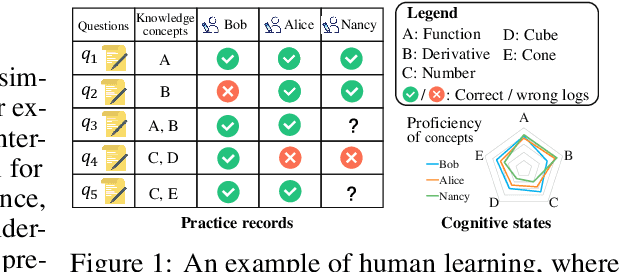
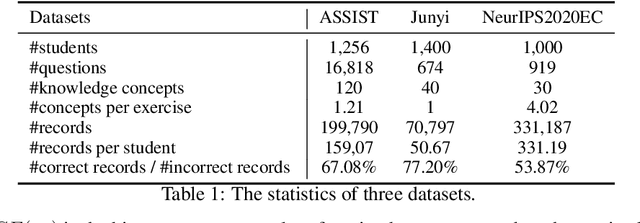
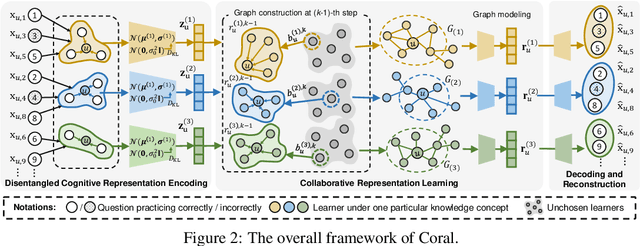
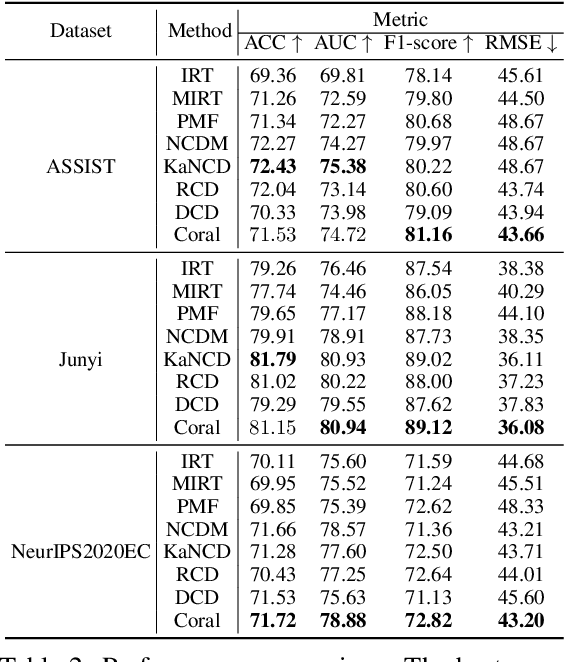
Abstract:Learners sharing similar implicit cognitive states often display comparable observable problem-solving performances. Leveraging collaborative connections among such similar learners proves valuable in comprehending human learning. Motivated by the success of collaborative modeling in various domains, such as recommender systems, we aim to investigate how collaborative signals among learners contribute to the diagnosis of human cognitive states (i.e., knowledge proficiency) in the context of intelligent education. The primary challenges lie in identifying implicit collaborative connections and disentangling the entangled cognitive factors of learners for improved explainability and controllability in learner Cognitive Diagnosis (CD). However, there has been no work on CD capable of simultaneously modeling collaborative and disentangled cognitive states. To address this gap, we present Coral, a Collaborative cognitive diagnosis model with disentangled representation learning. Specifically, Coral first introduces a disentangled state encoder to achieve the initial disentanglement of learners' states. Subsequently, a meticulously designed collaborative representation learning procedure captures collaborative signals. It dynamically constructs a collaborative graph of learners by iteratively searching for optimal neighbors in a context-aware manner. Using the constructed graph, collaborative information is extracted through node representation learning. Finally, a decoding process aligns the initial cognitive states and collaborative states, achieving co-disentanglement with practice performance reconstructions. Extensive experiments demonstrate the superior performance of Coral, showcasing significant improvements over state-of-the-art methods across several real-world datasets. Our code is available at https://github.com/bigdata-ustc/Coral.
Towards Few-shot Self-explaining Graph Neural Networks
Aug 14, 2024Abstract:Recent advancements in Graph Neural Networks (GNNs) have spurred an upsurge of research dedicated to enhancing the explainability of GNNs, particularly in critical domains such as medicine. A promising approach is the self-explaining method, which outputs explanations along with predictions. However, existing self-explaining models require a large amount of training data, rendering them unavailable in few-shot scenarios. To address this challenge, in this paper, we propose a Meta-learned Self-Explaining GNN (MSE-GNN), a novel framework that generates explanations to support predictions in few-shot settings. MSE-GNN adopts a two-stage self-explaining structure, consisting of an explainer and a predictor. Specifically, the explainer first imitates the attention mechanism of humans to select the explanation subgraph, whereby attention is naturally paid to regions containing important characteristics. Subsequently, the predictor mimics the decision-making process, which makes predictions based on the generated explanation. Moreover, with a novel meta-training process and a designed mechanism that exploits task information, MSE-GNN can achieve remarkable performance on new few-shot tasks. Extensive experimental results on four datasets demonstrate that MSE-GNN can achieve superior performance on prediction tasks while generating high-quality explanations compared with existing methods. The code is publicly available at https://github.com/jypeng28/MSE-GNN.
Empowering Few-Shot Relation Extraction with The Integration of Traditional RE Methods and Large Language Models
Jul 12, 2024Abstract:Few-Shot Relation Extraction (FSRE), a subtask of Relation Extraction (RE) that utilizes limited training instances, appeals to more researchers in Natural Language Processing (NLP) due to its capability to extract textual information in extremely low-resource scenarios. The primary methodologies employed for FSRE have been fine-tuning or prompt tuning techniques based on Pre-trained Language Models (PLMs). Recently, the emergence of Large Language Models (LLMs) has prompted numerous researchers to explore FSRE through In-Context Learning (ICL). However, there are substantial limitations associated with methods based on either traditional RE models or LLMs. Traditional RE models are hampered by a lack of necessary prior knowledge, while LLMs fall short in their task-specific capabilities for RE. To address these shortcomings, we propose a Dual-System Augmented Relation Extractor (DSARE), which synergistically combines traditional RE models with LLMs. Specifically, DSARE innovatively injects the prior knowledge of LLMs into traditional RE models, and conversely enhances LLMs' task-specific aptitude for RE through relation extraction augmentation. Moreover, an Integrated Prediction module is employed to jointly consider these two respective predictions and derive the final results. Extensive experiments demonstrate the efficacy of our proposed method.
Event Grounded Criminal Court View Generation with Cooperative (Large) Language Models
Apr 13, 2024



Abstract:With the development of legal intelligence, Criminal Court View Generation has attracted much attention as a crucial task of legal intelligence, which aims to generate concise and coherent texts that summarize case facts and provide explanations for verdicts. Existing researches explore the key information in case facts to yield the court views. Most of them employ a coarse-grained approach that partitions the facts into broad segments (e.g., verdict-related sentences) to make predictions. However, this approach fails to capture the complex details present in the case facts, such as various criminal elements and legal events. To this end, in this paper, we propose an Event Grounded Generation (EGG) method for criminal court view generation with cooperative (Large) Language Models, which introduces the fine-grained event information into the generation. Specifically, we first design a LLMs-based extraction method that can extract events in case facts without massive annotated events. Then, we incorporate the extracted events into court view generation by merging case facts and events. Besides, considering the computational burden posed by the use of LLMs in the extraction phase of EGG, we propose a LLMs-free EGG method that can eliminate the requirement for event extraction using LLMs in the inference phase. Extensive experimental results on a real-world dataset clearly validate the effectiveness of our proposed method.
Towards Faithful Explanations: Boosting Rationalization with Shortcuts Discovery
Mar 12, 2024



Abstract:The remarkable success in neural networks provokes the selective rationalization. It explains the prediction results by identifying a small subset of the inputs sufficient to support them. Since existing methods still suffer from adopting the shortcuts in data to compose rationales and limited large-scale annotated rationales by human, in this paper, we propose a Shortcuts-fused Selective Rationalization (SSR) method, which boosts the rationalization by discovering and exploiting potential shortcuts. Specifically, SSR first designs a shortcuts discovery approach to detect several potential shortcuts. Then, by introducing the identified shortcuts, we propose two strategies to mitigate the problem of utilizing shortcuts to compose rationales. Finally, we develop two data augmentations methods to close the gap in the number of annotated rationales. Extensive experimental results on real-world datasets clearly validate the effectiveness of our proposed method.
Cooperative Classification and Rationalization for Graph Generalization
Mar 10, 2024



Abstract:Graph Neural Networks (GNNs) have achieved impressive results in graph classification tasks, but they struggle to generalize effectively when faced with out-of-distribution (OOD) data. Several approaches have been proposed to address this problem. Among them, one solution is to diversify training distributions in vanilla classification by modifying the data environment, yet accessing the environment information is complex. Besides, another promising approach involves rationalization, extracting invariant rationales for predictions. However, extracting rationales is difficult due to limited learning signals, resulting in less accurate rationales and diminished predictions. To address these challenges, in this paper, we propose a Cooperative Classification and Rationalization (C2R) method, consisting of the classification and the rationalization module. Specifically, we first assume that multiple environments are available in the classification module. Then, we introduce diverse training distributions using an environment-conditional generative network, enabling robust graph representations. Meanwhile, the rationalization module employs a separator to identify relevant rationale subgraphs while the remaining non-rationale subgraphs are de-correlated with labels. Next, we align graph representations from the classification module with rationale subgraph representations using the knowledge distillation methods, enhancing the learning signal for rationales. Finally, we infer multiple environments by gathering non-rationale representations and incorporate them into the classification module for cooperative learning. Extensive experimental results on both benchmarks and synthetic datasets demonstrate the effectiveness of C2R. Code is available at https://github.com/yuelinan/Codes-of-C2R.
Communication-Efficient Personalized Federated Learning for Speech-to-Text Tasks
Jan 18, 2024Abstract:To protect privacy and meet legal regulations, federated learning (FL) has gained significant attention for training speech-to-text (S2T) systems, including automatic speech recognition (ASR) and speech translation (ST). However, the commonly used FL approach (i.e., \textsc{FedAvg}) in S2T tasks typically suffers from extensive communication overhead due to multi-round interactions based on the whole model and performance degradation caused by data heterogeneity among clients.To address these issues, we propose a personalized federated S2T framework that introduces \textsc{FedLoRA}, a lightweight LoRA module for client-side tuning and interaction with the server to minimize communication overhead, and \textsc{FedMem}, a global model equipped with a $k$-nearest-neighbor ($k$NN) classifier that captures client-specific distributional shifts to achieve personalization and overcome data heterogeneity. Extensive experiments based on Conformer and Whisper backbone models on CoVoST and GigaSpeech benchmarks show that our approach significantly reduces the communication overhead on all S2T tasks and effectively personalizes the global model to overcome data heterogeneity.
Zero-1-to-3: Domain-level Zero-shot Cognitive Diagnosis via One Batch of Early-bird Students towards Three Diagnostic Objectives
Dec 22, 2023

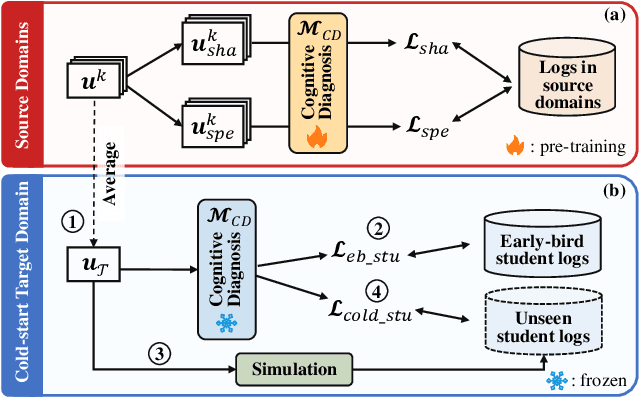
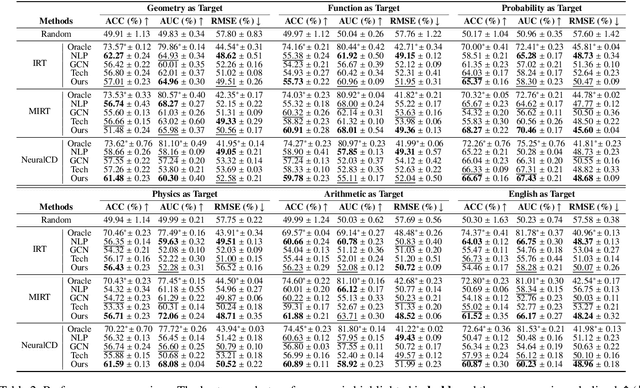
Abstract:Cognitive diagnosis seeks to estimate the cognitive states of students by exploring their logged practice quiz data. It plays a pivotal role in personalized learning guidance within intelligent education systems. In this paper, we focus on an important, practical, yet often underexplored task: domain-level zero-shot cognitive diagnosis (DZCD), which arises due to the absence of student practice logs in newly launched domains. Recent cross-domain diagnostic models have been demonstrated to be a promising strategy for DZCD. These methods primarily focus on how to transfer student states across domains. However, they might inadvertently incorporate non-transferable information into student representations, thereby limiting the efficacy of knowledge transfer. To tackle this, we propose Zero-1-to-3, a domain-level zero-shot cognitive diagnosis framework via one batch of early-bird students towards three diagnostic objectives. Our approach initiates with pre-training a diagnosis model with dual regularizers, which decouples student states into domain-shared and domain-specific parts. The shared cognitive signals can be transferred to the target domain, enriching the cognitive priors for the new domain, which ensures the cognitive state propagation objective. Subsequently, we devise a strategy to generate simulated practice logs for cold-start students through analyzing the behavioral patterns from early-bird students, fulfilling the domain-adaption goal. Consequently, we refine the cognitive states of cold-start students as diagnostic outcomes via virtual data, aligning with the diagnosis-oriented goal. Finally, extensive experiments on six real-world datasets highlight the efficacy of our model for DZCD and its practical application in question recommendation.
 Add to Chrome
Add to Chrome Add to Firefox
Add to Firefox Add to Edge
Add to Edge